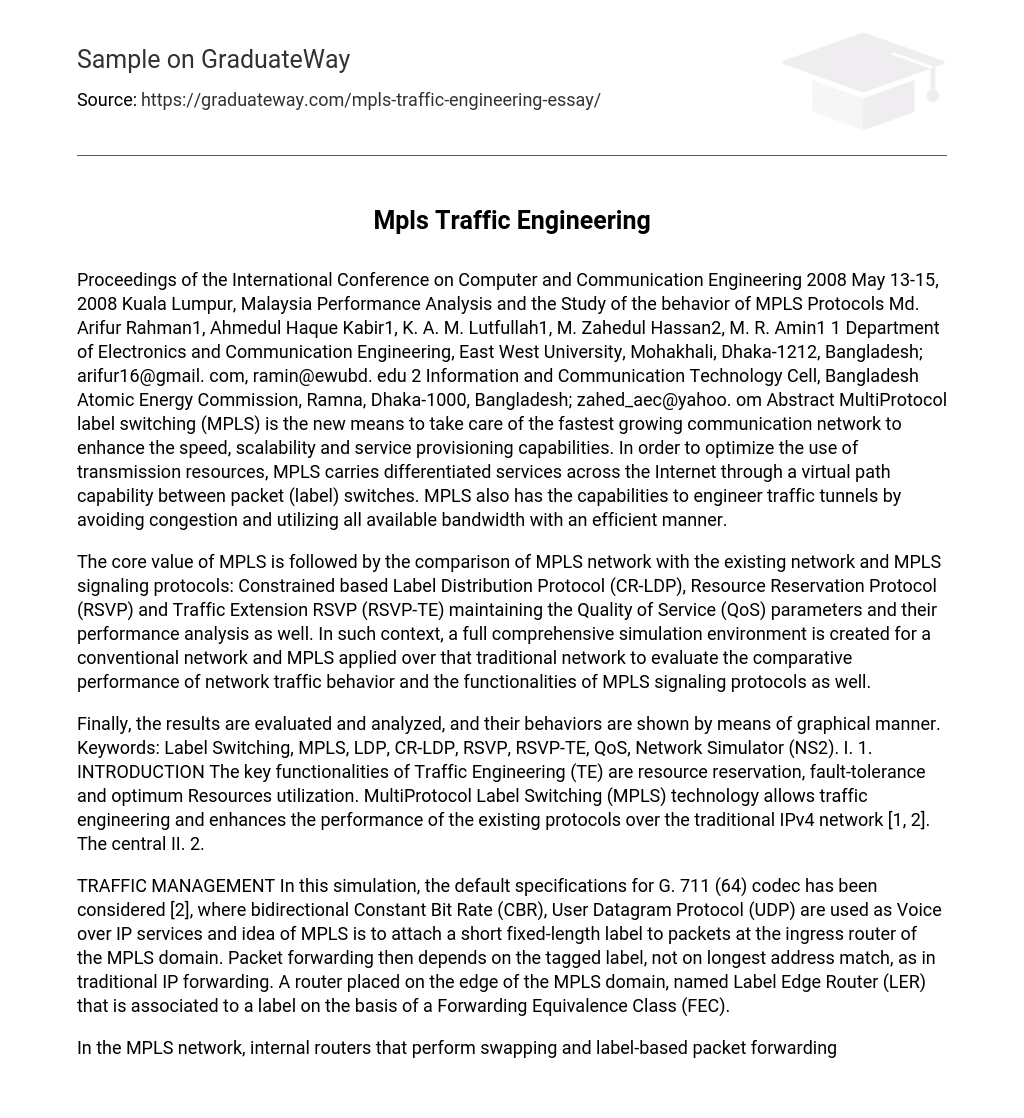MultiProtocol label switching (MPLS) is the new means to take care of the fastest growing communication network to enhance the speed, scalability and service provisioning capabilities. In order to optimize the use of transmission resources, MPLS carries differentiated services across the Internet through a virtual path capability between packet (label) switches. MPLS also has the capabilities to engineer traffic tunnels by avoiding congestion and utilizing all available bandwidth with an efficient manner.
The core value of MPLS is followed by the comparison of MPLS network with the existing network and MPLS signaling protocols: Constrained based Label Distribution Protocol (CR-LDP), Resource Reservation Protocol (RSVP) and Traffic Extension RSVP (RSVP-TE) maintaining the Quality of Service (QoS) parameters and their performance analysis as well. In such context, a full comprehensive simulation environment is created for a conventional network and MPLS applied over that traditional network to evaluate the comparative performance of network traffic behavior and the functionalities of MPLS signaling protocols as well.
Finally, the results are evaluated and analyzed, and their behaviors are shown by means of graphical manner. Keywords: Label Switching, MPLS, LDP, CR-LDP, RSVP, RSVP-TE, QoS, Network Simulator (NS2).
INTRODUCTION
The key functionalities of Traffic Engineering (TE) are resource reservation, fault-tolerance and optimum Resources utilization. MultiProtocol Label Switching (MPLS) technology allows traffic engineering and enhances the performance of the existing protocols over the traditional IPv4 network . The central II.
TRAFFIC MANAGEMENT
In this simulation, the default specifications for G. 711 (64) codec has been considered, where bidirectional Constant Bit Rate (CBR), User Datagram Protocol (UDP) are used as Voice over IP services and idea of MPLS is to attach a short fixed-length label to packets at the ingress router of the MPLS domain. Packet forwarding then depends on the tagged label, not on longest address match, as in traditional IP forwarding. A router placed on the edge of the MPLS domain, named Label Edge Router (LER) that is associated to a label on the basis of a Forwarding Equivalence Class (FEC).
In the MPLS network, internal routers that perform swapping and label-based packet forwarding are called Label Switching Routers (LSRs) [3]. Since MPLS by itself cannot provide service differentiation, combination of DiffServ with MPLS architectures seems to be a useful solution to provide QoS to multimedia traffic while effectively using network resources. The result of this integration is the DiffServ-aware Traffic Engineering (DS-TE). In order to enable DS-TE functionalities, DiffServ, MPLS and TE-related information have to be exchanged among routers through the control plane by means of a dynamic signaling protocol.
SIMULATION AND PERFORMANCE ANALYSIS
We have used NS2 to create the topology as shown in figure 1 for both traditional and MPLS networks. The simulation has been developed to emphasize the impact of Traffic Engineering over the traditional network. Nodes 0 and 1 are used as source and nodes 6 and 7 are used as destination. The information table 1 of node LSR2 act as Label Edge Router (LER) shown below, where egress router characterize FEC, label and LSPID. Labels of this table are distributed based on the control mode that is chosen to be executed at node LSR2.
During packet transmission, label swapping is done by each intermediate node. Routing information is stored in LIB, PFT and ERB tables using mapping message from egress router to ingress router(LSR2 to LSR7) and vice versa. Figure 2: Symmetric Network without MPLS In MPLS network, node 2 to node 5 is defined as LSR nodes. We have considered LSR2 as ingress and LSR5 as egress where the path through node 2_3_5 considered as shortest path. Due to the congestion at node 2, traffic engineering is applied for MPLS network. Traffic follows the alternative path (via node 2_3_5).
Figure 3: Symmetric Network with MPLS Figure 1: Simulation Topology In traditional network path (via node 2_4_5) is not utilized, while path (via node 2_3_5)is over utilized. Packets are lost due to congestion at node 2 and we have observed same situation when no traffic engineering is applied for MPLS network.
CONCLUSION
This paper has been prepared based on the traffic flow over both conventional and MPLS network, where network topology and other simulation parameters are chosen as common to establish the better performance of MPLS network over traditional network. Based on the comparison of signaling protocols, it can be found that RSVP has drawback in its scalability that is one reason for choosing CR-LDP for MPLS protocol. The results are obtained after some experimentation and calculation with network scale (number of nodes, link capacity and delay) and traffic arrangements (sources and packet sizes, and CBR packet arrival rates).





